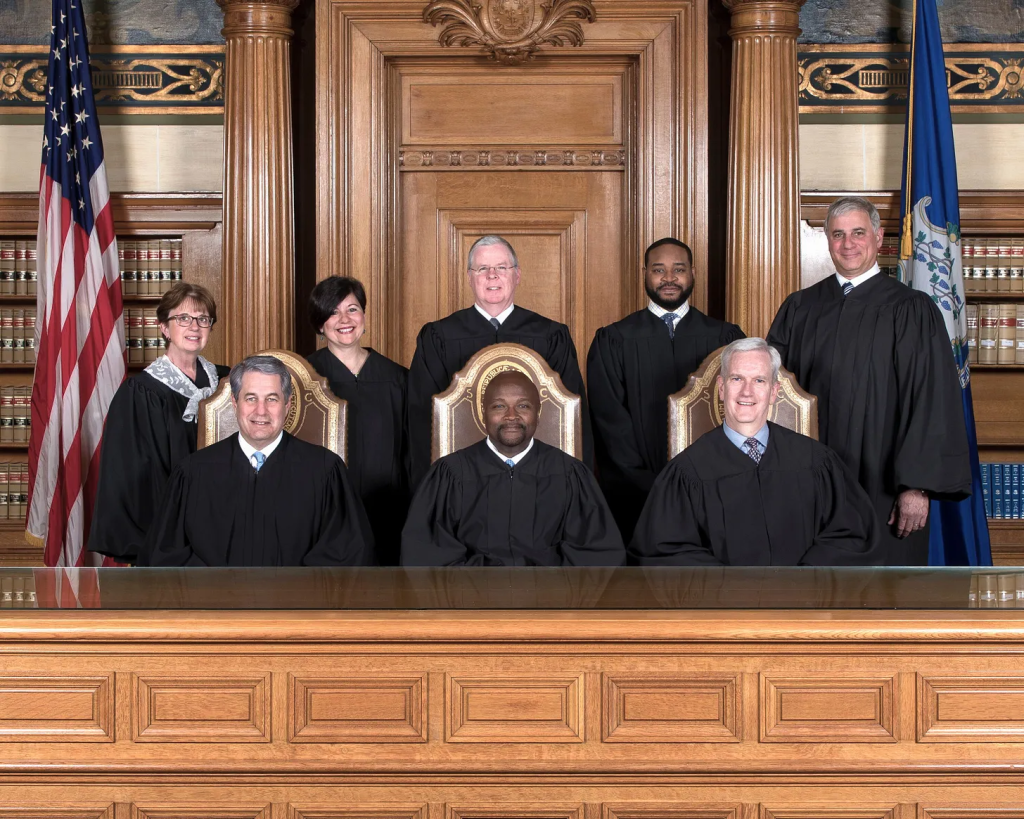
Please Follow us on Gab, Minds, Telegram, Rumble, Gettr, Truth Social, Twitter
In Connecticut, as elsewhere, the cogs of justice grind exceedingly slowly.
The characters in this First Amendment melodrama are two Republican state senators: present state Sen. Rob Sampson and former state Sen. Joe Markley; attorney Charles Miller, a senior counsel with the public interest law group Institute for Free Speech in Washington who is representing Sampson and Markley; the State Elections Enforcement Commission; and Deputy Associate Attorney General Maura Murphy Osborne, representing the state of Connecticut in a First Amendment case now before the state Supreme Court.
The case, sloshing around in various courts for ten years, has now arrived at the doorstep of Connecticut’s Supreme Court.
One report tells us: “The case arose from the 2014 election, when Markley and Sampson were fined by the State Elections Enforcement Commission for using a portion of their public campaign grants on postcards targeting then-Gov. Dannel P. Malloy.
“The two then-Senate candidates were punished for breaking a campaign law that prohibited them from criticizing Malloy by name in post cards delivered by mail. To comply with the law, the two should have solicited money from another campaign organization and paid for the mailings with that money. Or they should have used a form of advertising that didn’t involve delivery by mail. Or they shouldn’t have identified Malloy.”
The First Amendment to the U.S Constitution provides a right to free speech most especially, any student of the Bill of Rights would agree, in the case of political speech.
Through the years, the high court has spoken with one voice in its free speech decisions, favoring a robust interpretation of the First Amendment: “Congress shall make no law [emphasis mine] respecting an establishment of religion, or prohibiting the free exercise thereof; or abridging the freedom of speech, or of the press; or the right of the people peaceably to assemble, and to petition the government for a redress of grievances.”
The amendment applies as well to state legislatures and rules, which have the force of law, made by unelected administrative organs of the state.
In Schenk v. U.S., Justice Oliver Wendell Holmes Jr. outlined in 1919 the borders of the free speech amendment. A restriction on the free speech amendment is permissible only if the speech in question poses a “clear and present danger”—i.e., a risk or threat to safety or to other public interests that is serious and imminent.
Nothing printed by Samson or Markley would seem to trigger the Holmes exception – and, therefore, a decision against the restricting authority, the State Elections Enforcement Commission, should have been a slam-dunk for the lower courts.
Yet, ten years after Samson and Markley brought the violation of their First Amendment right before Connecticut’s bar, here we are, still in litigation after all these years.
From news accounts, it would appear that Connecticut’s high court is not friendly to right of free speech impositions in “The Constitution State.” Connecticut is called The Constitution State because The Fundamental Orders, issued in 1639, are regarded by most historians as a primitive constitution, a historic herald of other state and national constitutions.
Deducing a final decision by a high court from questions asked by justices is a bit like deducing the guilty party in a complex Agatha Christie mystery before the final page is turned. But, here is Justice Joan K. Alexander questioning Murphy Osborne, who has argued that the two Republican senators might have satisfied the First Amendment restriction on their constitutional rights by criticizing then Governor Malloy using an instrument other than a campaign postcard that mentioned the governor’s name in some other acceptable formant.
According to the news report, “Deputy Associate Attorney General Maura Murphy Osborne told the court, had the two Republicans used their campaign grants to criticize Malloy in different sorts of ads — such as banners towed behind airplanes and postcards delivered to potential voters by hand… It also would have been legal for Markley and Sampson to attack Malloy’s tax policy in mailed postcards if they had not identified him by name, but by some euphemistic formulation such as ‘That Democrat in Hartford.’”
“So,” Justice Alexander remarked, “it is preferable to use some slang derogatory term about a person than to use the actual name in a respectful way?”
Osborne answered, “I don’t think we are encouraging slang or derogatory terms. But what you can say is that ‘The Democratic leadership is destroying the state.’ They can say the same things they said about Governor Malloy that could have been said in other ways that did not clearly identify Gov. Malloy.”
“What is the distinction?” Alexander asked. “It is still Gov. Malloy’s policy.”
“The distinction is that the General Assembly has decided to leave ample First Amendment breathing room and candidates can talk all the way up to the line. They can say every kind of euphemistic thing criticizing Gov. Malloy or any other elected official. What they can’t do … is they cannot clearly identify a candidate.”
Hopefully, the State Supreme Court in its final decision will remind all involved that when the state through its various agencies, is prohibiting campaign speech or instructing state politicians what they may say, how they may say it, and when they may say it, the state has violated imprescriptible free speech rights – and that is a no, no.
